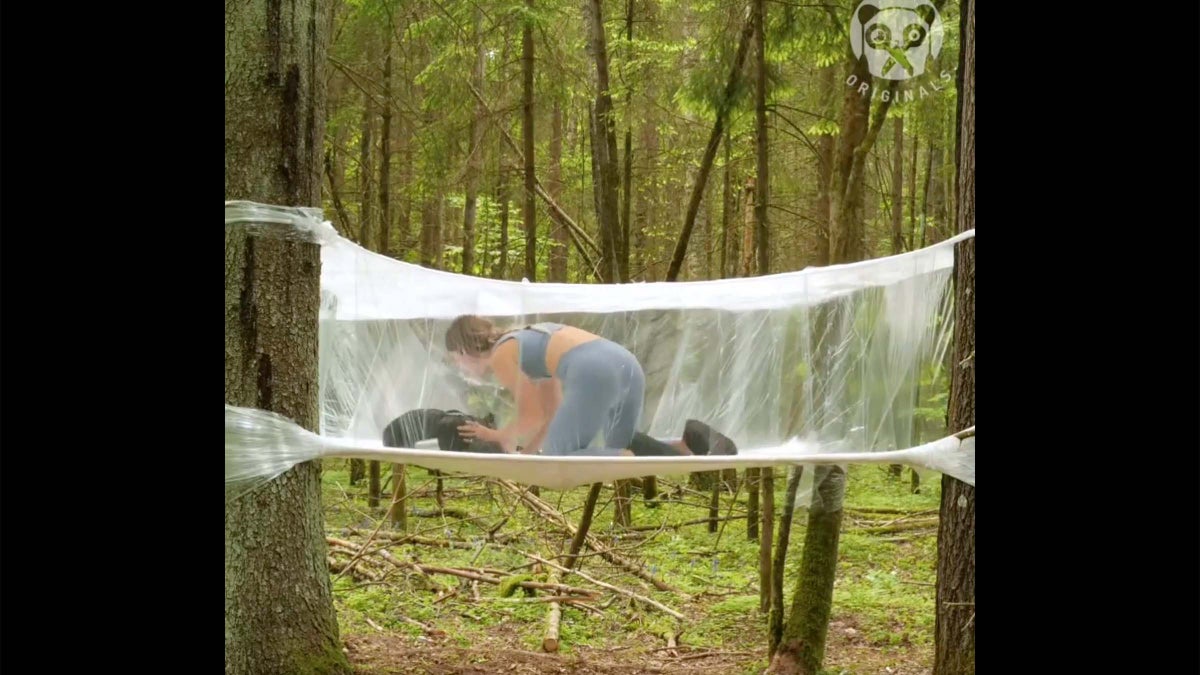Products You May Like
Get full access to Outside Learn, our online education hub featuring in-depth fitness, nutrition, and adventure courses and more than 2,000 instructional videos when you sign up for Outside+
Sign up for Outside+ today.
The social media hack video is a unique kind of snake oil. As royalty-free muzak plays in the background, someone spends 30 seconds demonstrating how to do some hard, inconvenient, or expensive thing more easily or cheaply—cook a soufflé in your microwave! Make a chair out of pool noodles! Turn old Frisbees into shoes! The truth is, of course, that none of these hacks actually work; someone swapped in a real soufflé during a hard cut, and Frisbee shoes are unbearably painful after a dozen steps. It’s Internet Age MacGyver shit, low-rent stage magic dressed up as self-help.
I’m willing to bet a plastic wrap tree tent would work—at least for a little while. If you don’t know what I’m talking about, the latest “hack” video to go viral shows a camper laboriously constructing a sleeping platform by wrapping what looks like roughly a mile of cling film around four trees, then doing the same higher up to create a roof. Finally, she encloses the whole thing in plastic wrap walls to create what’s essentially a single-wall tent, suspended feet off the ground. It does seem to hold her weight, at least for the few seconds that she sits on it.
But just because something works in the barest sense of the word doesn’t mean it works. In middle school, my friends and I duct-taped one of our classmates to the wall so thoroughly that he spent the last 20 minutes of class hanging in a tape pupa, but I wouldn’t suggest you throw out your chairs. And the plastic wrap tree tent has a couple of problems.
Let’s get the environmental impact out of the way first: This is a one-time-use tent made out of a pile of non-recyclable plastic. If I were determined to do that much pointless damage to the planet, I would cut out the middleman and just strangle a porpoise.
I also hope you like being moist, because plastic wrap does not breathe, at all. The more you sweat—and you will sweat, because in addition to being a tent, this translucent abomination you’ve created is also a greenhouse—the steamier and wetter it’s going to get. All that condensation is going to collect in the low point around your sleeping bag the minute you lie down. As someone who’s spent his fair share of nights sleeping under a space blanket, take it from me: Starting your morning by wiping sweat droplets off your bedding, tent floor, and yourself is no fun.
Maybe you don’t care about being comfortable. Maybe you just want the lightest gear you can find. Well, then I have news for you: This tent sucks at that too. Over the course of the video, we see the person building the tent go through at least a dozen commercial-size rolls of what appears to be industrial-strength plastic wrap. Assuming she used the same amount to make the roof, that’s a whopping 120 pounds of plastic wrap, all of which you’ll have to pack out later (assuming you don’t just abandon it in the woods, that is). That’s at least 10 times the weight of the heaviest tents. It’s going to take you far more than 10 times as long to pitch, too.
But building a tent out of plastic wrap should be cheap, at least, right? Unfortunately, this brilliant life hack doesn’t even have that going for it. By our back-of-the-envelope calculations, buying this much heavy-duty plastic wrap on Amazon will run you about $130. Considering that you’ll probably have to rebuild it every night like some kind of petroleum-spinning spider, you’re looking at about $900 for a week of camping.
So let this be your lesson, sweet reader, that internet advice is not always good advice. A better plan: Invest in a dedicated tree tent. The Tentsile Flite is a 2-person, 10-pound tent that you can rig on three trees. At $399, it will cost you a little less than three times the price of this weird stunt, but on the other hand, you won’t have to throw it in the trash when you break camp.
